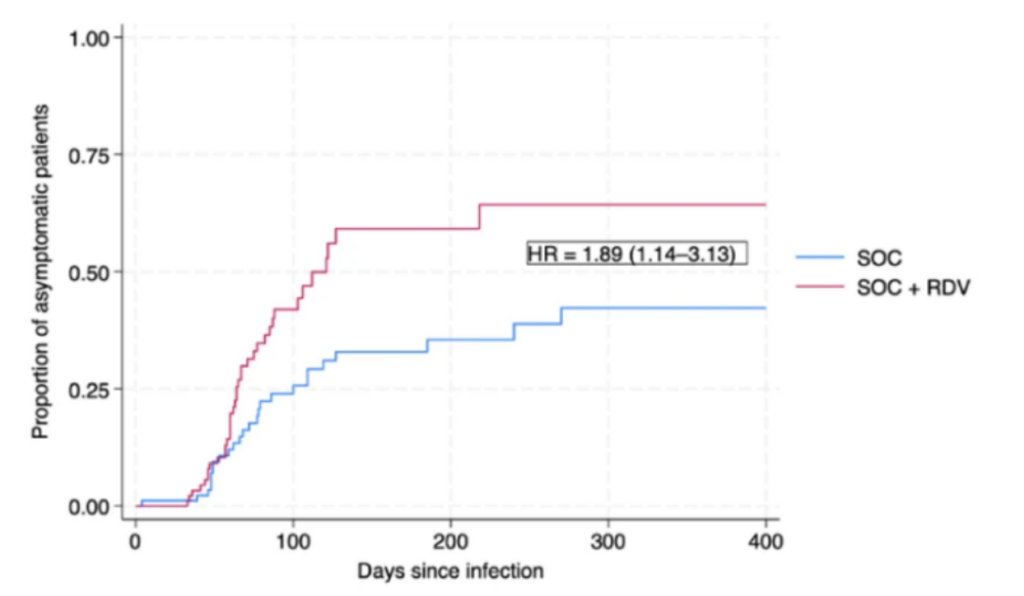COVID-19
Long COVID
🎉 This paper from Hungary (2025-01-09) reports that people who got remdesivir while they were hospitalized with COVID-19 recovered from Long COVID symptoms faster than those who did not get remdesivir.

🎉🎊🥳 If you missed it last week, this paper reports that nasal chlorpheniramine (a first-generation H1 antagonist antihistamine) works really well to prevent Long COVID. 🎉🎊🥳
I have not found an over-the-counter nasal chlorpheniramine in Canada or the USA, but there *are* some other H1 antagonist antihistamine nasal sprays which are available over-the-counter in the USA:
- Astepro nasal spray, active ingredient azelastine (
firstsecond-generation H1, available over-the-counter) - Livostin Nasal Spray, active ingredient levocabastine (second generation H1, prescription-only)
I am not a doctor or pharmacist: I don’t know or even have intuition about how much difference the exact drug makes. However, I have found out that first-generation H1 antihistamines cross the blood-brain barrier, unlike the second-generation ones (<- search for “brain” at that link). Maybe you want the antihistamine to cross the blood-brain barrier so that it blocks SARS-CoV-2 in the brain, I don’t know. (NB: First-gen antihistamines make you sleepy and second-generation ones do not precisely because the second-gen ones don’t cross the blood-brain barrier.)
This page lists first-gen vs. second-gen antihistamines.
AGAIN This big survey of Minnesotans (2025-01-14) found that 40% had at least one Long COVID symptom after three months, and 20% reported a severe symptom. 66% of those who had at least one symptom after three months reported difficulty in performing daily activities.
53% of unvaccinated people had a long-lasting symptom while only 37% of people who had gotten a booster did.
AGAIN This paper from USA (2025-01-08) reports that multiple bouts of COVID-19 or severe COVID-19 increases the risk of Long COVID.
- multiple infections increases the risk by 41% over controls;
- severe infection increases the risk by 3.17 times over controls;
- being unvaccinated at the time of first COVID-19 infection increases the risk by 3.29 times over controls.
This paper from Switzerland (2024-11-12) reports on a study of Long COVID among a cohort of health care workers from multiple centres.
- They found that 30% had Long COVID symptoms.
- 15% reported symptoms severe enough to interfere with daily activities.
- 74% tried at least one measure for their symptoms, and 84% of those who tried found some benefit from whatever they did.
- In March 2021, there was a 21% higher risk from COVID Classic than from subsequent strains.
- There was a 7% decrease in Long COVID cases over the 30-month study.
AGAIN This paper from Spain (2025-01-15) reports that Long COVID have different brain volumes; in this case, it’s the choroid plexus which is enlarged.
COVID-Related Excess Sickness and Death
😞 This paper from USA (2024-12-30) reports that people who had COVID-19 infections had an 18% higher risk of new-onset gastrointestinal disease compared to controls 3.5 years after their infection.
🤯 This case study from Japan (2024-12-07) describes a man who developed an unusual cold-temperature-related syndrome after a COVID-19 infection. Cold agglutinin disease (CAD) happens when antibodies that normally attack bacteria instead attack red blood cells at temperatures under 30C (86F). This one guy was severely anemic after a COVID-19 infection, and they figured out it was because of CAD.
🤯🤯 There have been a few cases of sudden, massive breast growth after COVID-19 vaccinations (this case in the USA (2022-09-27) and this case in Canada (2024-12-20). Ow!
Vaccines
😞 This article (2025-01-10) reports that the federal government is no longer going to pay for COVID-19 vaccines, nor will it issue guidance on the timing of vaccinations (which I think means who is eligible): both will now be up to the provinces.
🎉🎉 This paper from USA (2025-01-09) reports that getting vaccinated and/or infected with COVID classic first (as almost everybody did) gave “original antigenic sin”, i.e. subsequent exposures (either vaccination or infection) didn’t build up immunity to Omicron strains as you would hope/expect.
JN.1 appears to be different. People who had multiple JN.1 exposures did in fact generate antibodies which were effective at neutralizing a broader range of variants.
Treatments
🎉🎉 This older paper from Germany (2023-08-03) found that people taking a particular anti-osteoporosis drug (bisphosphonate) were about 75% less likely to get COVID-19 or be hospitalized. Looking at electronic records from 2019, they found that people taking bisphosphonate had similarly lower risks of getting pneumonia or bronchitis, which suggests that bisphosphonate is kind of a general anti-respiratory-infection-drug.
This older paper (2024-03) reports that computer modelling suggests that the osteoporosis drug alendronate (as well as the mast cell stabilizer cromolyn, the anti-fungal natamycin and the blood pressure medicine treprostinil) ought to work against COVID-19.
This recent paper (2025-01-11) reports that computer modelling of drugs which bind to SARS-CoV-2’s RNA-dependent RNA polymerase (RdRp) found the anti-osteoporosis drugs minodronate and zoledronate. Those ought to be effective COVID-19 treatments.
This article (2025-01-07) talks about how Paxlovid is being prescribed less than one might want, and specifically calls out a study which said it wasn’t useful — overlooking that the study said that it was extremely useful for people in certain high-risk groups: “a study originally targeted to individuals at lower risk for severe outcomes from COVID-19 infection has been used to influence policy for high-risk populations”.
😞 This preprint from USA (2025-01-15) reports that metformin did not reduce hospital stays significantly. 🙁
❗This paper from France (2024-12-05) investigated how drugs used for treating connective tissue disorders (CTD) affected COVID-19 severity. In patients with CTD:
- glucocorticoids (a type of steroid), leflunomide (immunosuppressive disease-modifying antirheumatic drug DMARDs), sulfasalazine (another DMARDs), mycophenolate (an immunosuppressant) derivatives, and rituximab (a type of monoclonal antibody) made COVID-19 worse;
- Tumor necrosis factor inhibitors made COVID-19 better;
- methotrexate (an immunosuppressant) reduced mortality.
This is obviously useful research for anyone who has a CTD, but there might be clues in this that could lead to finding drugs that would help everybody.
🎉 This paper from China (2025-01-17) reports that azduvine is not inferior to Paxlovid for hospitalized patients. It also is significantly better for patients with cancer.
Mitigation Measures
🤔 This paper from USA (2025-01-07) reports that greater broadband Internet access correlated strongly with lower mortality and slightly with more mask wearing. For a period in 2020, a 1 percentage point increase in broadband access resulted in 0.12 per 100,000 residents fewer weekly deaths.
(I really wonder if there’s not another factor that correlates with both internet access and lower mortality, like urban/rural divide, financial resources, political leaning, etc… but the paper says they did control for social capital, age, race, political leaning, and many other things.)
Better Internet access could reduce mortality in several ways, including making staying home easier and making information about mitigation measures easier to access.
Transmission
😞 This paper (2025-01-10) reports that all of a small group of captive deer in Texas had either active COVID-19 or COVID-19 antibodies. All were Omicron, but with significant mutations. That could be trouble if their virus decides to jump back into people.
Pathology
🍾🥂🎉 Good news! This paper (2024-01-13) found that 95% of kids who had MIS-C had a full recovery by six months later.
Recommended Reading
This article (2025-01-14) tries to understand why COVID-19 is becoming less lethal: is it because people are developing immunity, or is the virus becoming milder? Spoiler: it asks good questions, but does not have an answer.
This opinion article (2025-01-10) discusses why kids in BC are sick “all the time now”. They debunk the “immunity debt” theory and offer the “immunity theft” theory: that COVID-19 has damaged our immune systems.
H5N1
Pathology
🤔 This paper (2025-01-15) reports on infecting macaques with H5N1 via several routes: by the upper respiratory tract, by the lower respiratory tract, and by the stomach.
- The monkeys who got infected via the lower respiratory tract got really sick.
- The monkeys who got infected via the upper respiratory tract got sick, but not badly.
- The monkeys who ate H5N1 showed limited signs of infection and no signs of illness.
THIS STILL DOESN’T MEAN YOU SHOULD DRINK INFECTED RAW MILK! It’s encouraging that the macaques didn’t get sick via the oral route, but humans are not macaques.
Transmission
😞 This article (2025-01-16) reports that the total ever-infected herds since in the USA is now 928, with 711 in California.
😞 💀🐈 This release (2025-01-13) reports that three more housecats in LA County have died after eating infected pet food.
This press release (2025-01-13) reports that a child in San Francisco tested positive for an H5N1 infection 😞, with a fever and conjuntivitis, but has recovered 🎉. They still are investigating how the child caught it. The poor kid tested positive for H5N1 and RSV and COVID-19!
Mpox
🤔 Mpox is still going on, but this article (2025-01-17) makes it sound like it’s getting a little more under control. Four of eight African countries with outbreaks have had zero new cases for three months, vaccine has arrived, and the vaccine “has been well-received”.
